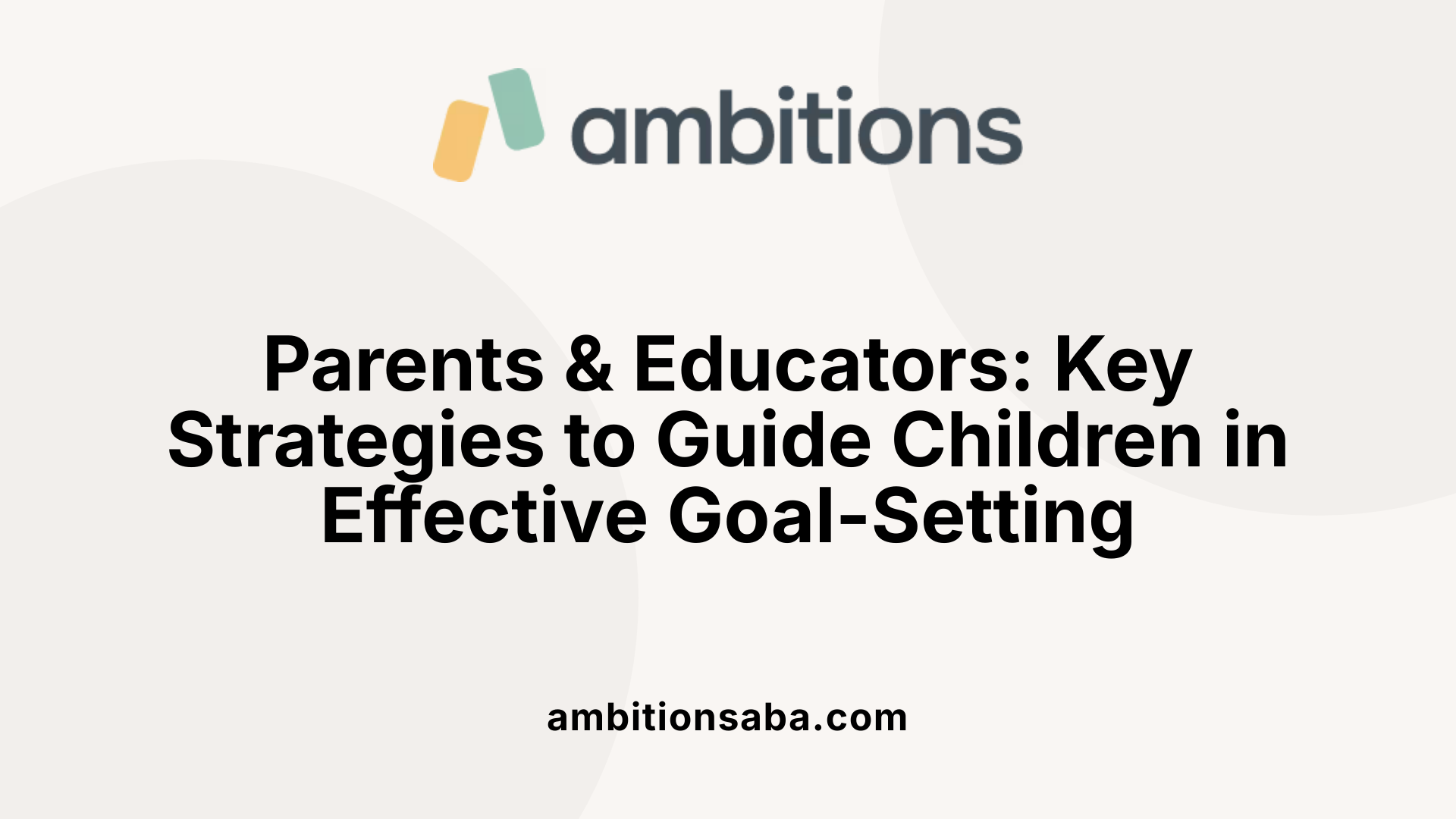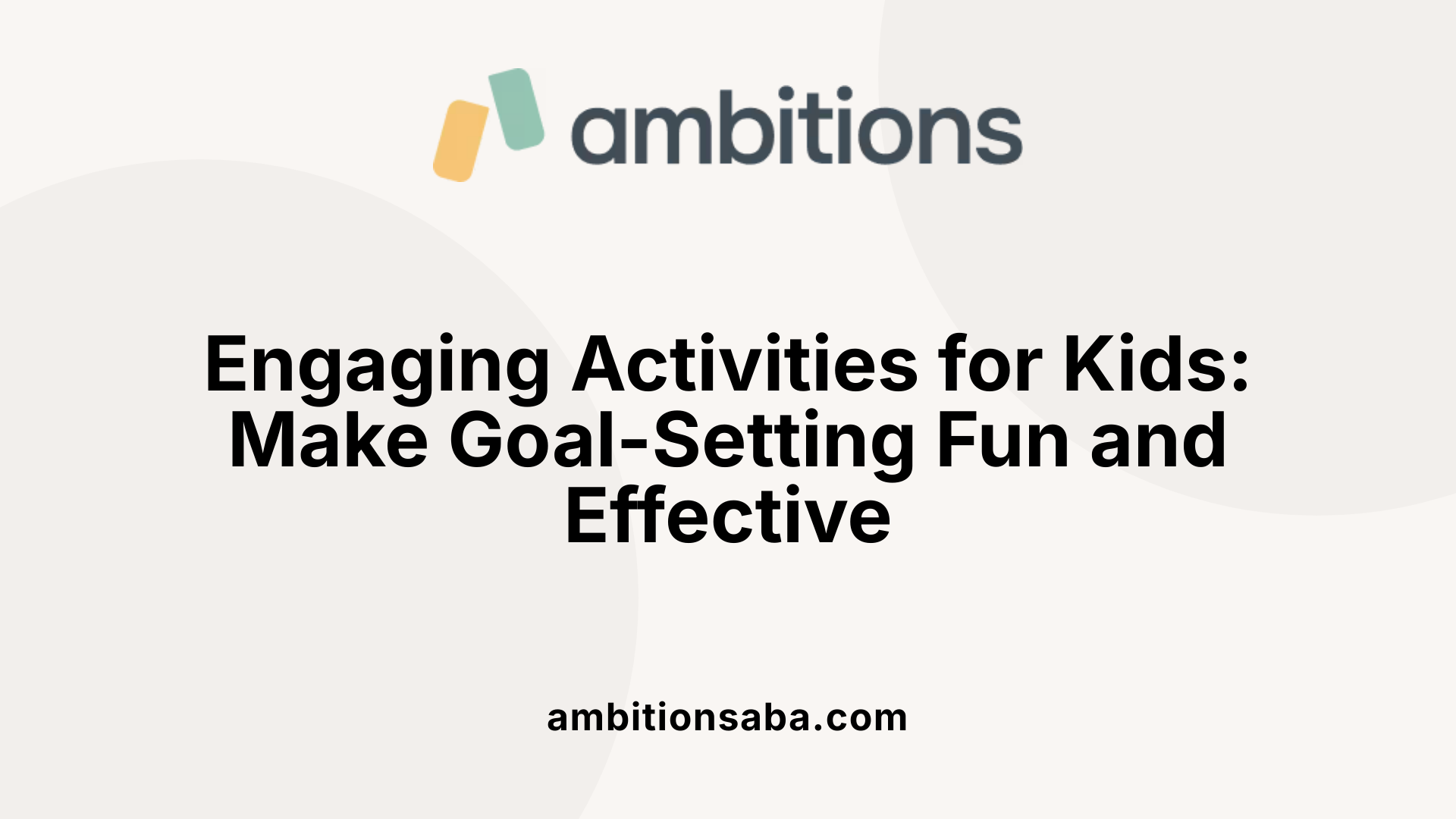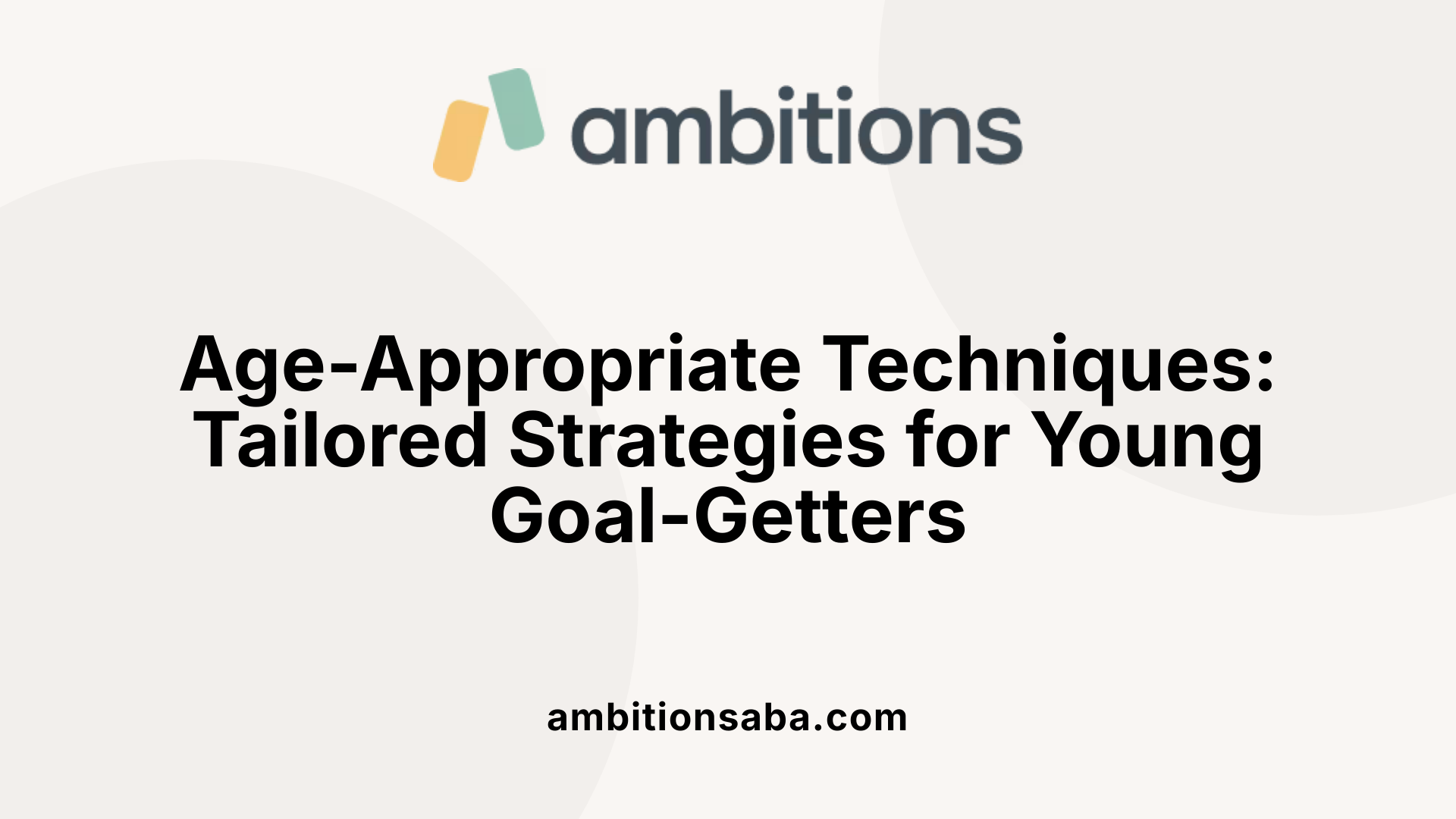Building Bridges: How Pairing Transforms Early ABA Therapy
Empowering Kids with Key Skills for Lifelong Growth
Teaching goal-setting to older children—a crucial developmental skill—lays the foundation for motivation, resilience, and academic achievement. This article explores effective strategies, engaging techniques, and practical tools to help parents and educators guide children in setting meaningful goals that nurture independence and perseverance.
Understanding the Benefits of Goal-Setting for Older Children
 Teaching goal-setting to older children offers many advantages that support their overall growth and academic achievement.
Teaching goal-setting to older children offers many advantages that support their overall growth and academic achievement.
One of the most notable benefits is the development of motivation and confidence. When children learn to set and pursue specific goals, they begin to see their own potential for success, which boosts their self-esteem and encourages them to tackle new challenges.
Goal-setting also fosters responsibility and self-discipline. By creating plans, monitoring progress, and reflecting on outcomes, children become more accountable for their actions and develop habits of persistence and effort.
Additionally, working on goal-setting enhances important life skills such as planning, time management, and resilience. Children learn to break ambitious objectives into manageable steps, prioritize tasks, and adapt when faced with setbacks.
Fostering a growth mindset is another crucial outcome. When children understand that abilities can improve through effort and perseverance, they develop a positive attitude toward learning and self-improvement.
Using frameworks like SMART goals—making objectives Specific, Measurable, Achievable, Relevant, and Time-bound—guides children toward setting realistic targets. Regular reflection and celebrating milestones reinforce motivation and help children view setbacks as opportunities to grow.
Involving family members in goal discussions and encouraging self-reflection bolster motivation and deepen their sense of ownership. This collaborative approach makes goal-setting a meaningful part of their development.
Overall, teaching goal skills equips older children with essential tools for academic success and lifelong resilience, shaping them into proactive, motivated, and confident individuals ready for future challenges.
Guiding Children in Goal-Setting: Roles of Parents and Educators

How can parents and educators guide children in setting and achieving goals?
Parents and teachers play a fundamental role in helping children develop effective goal-setting skills. They can begin by modeling goal-oriented behavior themselves, demonstrating how to set, plan, and pursue objectives. Children often imitate adults; showing enthusiasm for personal goals teaches children that setting targets is valuable.
Providing simple, clear instructions tailored to children's developmental levels is also essential. For early learners aged 5 to 10, using visual aids such as goal charts, worksheets, or visual cues like diagrams can make the process engaging and understandable.
Incorporating fun activities transforms goal setting from a task into an enjoyable experience. Creative projects like drawing vision boards, making paper goal chains, or playing games like 'Three Stars and a Wish' promote positive attitudes and motivation. These activities encourage children to think about their aspirations while having fun.
Teaching children about SMART goals—making goals Specific, Measurable, Achievable, Relevant, and Time-bound—provides them with a structured framework. Breaking bigger aims into smaller, manageable steps boosts confidence and creates clear pathways toward achievement.
Addressing fears of failure by fostering a safe environment for reflection is crucial. Parents and teachers should emphasize that setbacks are part of learning, helping children see challenges as opportunities for growth. Regular reviews of progress and celebrating small successes reinforce motivation and resilience.
Finally, collaboration between parents and educators strengthens children’s accountability and encourages ongoing engagement. By discussing progress openly, offering encouragement, and setting realistic expectations, adults help children cultivate habits of perseverance, independence, and lifelong learning.
Methods and Activities for Effective Goal-Setting Education

What are effective methods for teaching goal-setting to children and teenagers?
Teaching goal-setting effectively involves engaging children at their developmental stage with activities that are both fun and instructive. For young children aged 5 to 10, simple exercises like filling out worksheets or creating visual tools such as vision boards or goal chains make the concept tangible. These visual approaches help kids see what they want to accomplish and motivate them to take steps towards their goals.
For older children and teenagers, more detailed planning activities work best. Introducing goal execution plans, action steps, and goal ladders make goals more concrete and achievable. Using interactive tools like charts, journals, or interest maps can help track progress and foster responsibility.
Parents and teachers should encourage regular reflection on progress, celebrate small victories, and discuss setbacks as learning opportunities. Modeling goal-oriented behavior—such as sharing personal goals and how they achieve them—demonstrates practical application and inspires resilience.
Incorporating activities suited to age increases engagement and understanding. Structured routines like reviewing progress weekly or monthly and rewarding effort reinforce perseverance and foster lifelong planning skills.
Age-Appropriate Goal-Setting Techniques to Engage Young Minds

What are some engaging and age-appropriate goal-setting techniques for children and teens?
Children and teenagers benefit from goal-setting methods that are simple, visual, and fun, helping them stay motivated and learn valuable skills.
For young children aged 5 to 10, visual tools like colorful charts, stickers, and visual cues are particularly effective. These can include drawing or coloring their goals, creating visual goal chains, or using pictures in vision boards that depict what they want to achieve. Simple worksheets and activity books tailored to their age can guide them through setting small, achievable goals while making the process enjoyable.
As children grow into middle and high school, more detailed approaches become appropriate. Using goal-setting templates, journaling, and mini action plans can encourage deeper reflection. Techniques like breaking goals into smaller steps, applying the SMART framework—Specific, Measurable, Achievable, Relevant, Time-bound—and setting checkpoints help teenagers understand the importance of planning and persistence.
Fun activities and games are also powerful tools. Games like 'Three Stars and a Wish' promote self-assessment, while group projects or challenges foster teamwork and accountability. Creativity exercises, such as making vision boards with images and words that represent personal ambitions, can keep motivation high.
Connecting goals to personal values or happiness is especially impactful for teens, as it enhances intrinsic motivation. For example, discussing how their goals align with their interests or long-term dreams creates a meaningful purpose behind their efforts.
Involving family, teachers, and peers through collaborative goal-setting activities strengthens support networks. Regular celebrations of progress—no matter how small—reinforce positive habits. Recognizing the effort as much as the achievement helps develop resilience and confidence.
Overall, combining visual tools, engaging activities, and a focus on personal relevance makes goal-setting accessible and enjoyable for children and teens, laying a strong foundation for lifelong skills in motivation and perseverance.
The 5-4-3-2-1 Goal-Setting Method: A Practical Approach
The 5-4-3-2-1 goal-setting method is a simple yet effective way to help children and teenagers develop their planning skills by breaking down larger goals into manageable parts. This method involves defining objectives across different timeframes: five years, four months, three weeks, two days, and one hour.
By dividing goals into these segments, young learners can connect their long-term ambitions with short-term actions. For example, a student aiming to improve their science grades might set a long-term goal of becoming a top student in five years. With that vision in mind, they could plan to study specific topics over the next four months, review key concepts in three weeks, focus on weekly assignments in two days, and prepare for tests in the next hour.
Breaking down goals into timeframes
This approach helps children visualize the steps needed to achieve big ambitions. Starting with the most distant goal, they can work backward to identify immediate actions. Teachers and parents can support this process by drawing diagrams or creating visual goal chains. This structured breakdown makes goals less daunting and more accessible.
Strategic planning and prioritization
Using the 5-4-3-2-1 model encourages young learners to prioritize their efforts. It teaches them to focus on what’s most important now, while keeping sight of their ultimate objectives. Developing such strategic thinking early on fosters organizational skills and a growth mindset.
Tracking progress and maintaining motivation
Regularly reviewing progress within each timeframe helps children stay motivated and recognize their achievements. Parents and teachers can celebrate milestones, like completing a mini-project or reaching a step in their plan. This reinforcement builds confidence and resilience, showing kids that consistent effort pays off.
Applying the 5-4-3-2-1 method creates a balanced framework for setting and achieving goals. It empowers children to take ownership of their tasks, plan effectively, and develop persistence—traits essential for success in school and beyond.
The Four P's of Goal-Setting: Key Elements for Success
What are the 4 P's of goal-setting?
The 4 P's of goal-setting are Purpose, Plan, People, and Power. These elements serve as foundational pillars that guide individuals, including children and students, toward achieving their objectives effectively.
Purpose refers to having a clear vision or goal that inspires and motivates children. It helps them understand why they are pursuing a certain target, whether it's learning to balance on one foot or saving for a school trip.
Plan involves creating strategies and laying out steps to reach the goal. Breaking larger objectives into smaller, manageable steps makes it easier for kids to track progress and stay motivated.
People denote the team or support system involved in the process. This could include parents, teachers, or friends who encourage and assist children, making the journey collaborative and less overwhelming.
Power encompasses the resources needed to succeed, such as learning tools, time, and encouragement. Ensuring children have access to these supports enhances their ability to stay committed and overcome challenges.
Aligning and managing these four components—Purpose, Plan, People, and Power—boosts focus, encourages persistence, and increases the chances of success. Introducing these concepts early can help children develop essential skills like planning, resilience, and teamwork, setting a strong foundation for lifelong goal achievement.
Utilizing the 5 W's for Effective Goal-Setting
Teaching children how to set goals effectively involves guiding them through key questions known as the 5 W's: who, what, where, when, and why. These questions help children define clear and specific objectives that are both meaningful and relevant to their lives.
When children identify who is involved, what they want to achieve, where the goal will take place, when they plan to accomplish it, and why it matters, they develop a comprehensive understanding of their targets. This process makes their goals precise and connected to their personal interests, which boosts motivation.
Using the 5 W's encourages critical thinking by prompting children to consider various aspects of their goals. For example, asking 'how'—a vital part of the SMART goal framework—helps in planning actionable steps and realistic timelines. Breaking down goals into smaller parts with these questions increases accountability, responsibility, and a sense of ownership.
Incorporating this approach not only clarifies what children should do but also fosters confidence as they learn to create achievable plans. Ultimately, teaching kids to utilize the 5 W's helps establish strong habits for setting efficient goals, promoting personal growth, resilience, and lifelong success.
Building a Bright Future Through Goal-Setting
Introducing older children to goal-setting skills not only boosts their academic and personal success but also equips them with invaluable tools for lifelong growth. By combining age-appropriate activities, strategic frameworks like SMART goals, and engaging visual tools, parents and educators can foster a proactive mindset rooted in resilience, responsibility, and independence. Reflective exercises, celebrating milestones, and modeling perseverance help develop qualities essential for future success. When children understand how to plan, track, and adapt their goals, they cultivate confidence and resilience—traits that serve them well beyond childhood. Empowered with these skills, older children are better prepared to navigate challenges, pursue their aspirations, and realize their full potential, setting the stage for a successful and fulfilling life.
References
- 15 Fun Goal-Setting Activities for Students & Kids
- Six Parent Tips on Goal Setting with Your Child | Edmentum
- 10 Ways to Help Children Learn Goal Setting Skills
- Learning How to Set Goals With Donkey Hodie - PBS
- Goal Setting with Kids: 7 Tips for Teachers - Andrea Knight
- 4 Steps to Goal Setting for Kids – FREE Printable - Scholar Within
- Goal Setting for Kids: How to Teach Kids How to Set Goals

